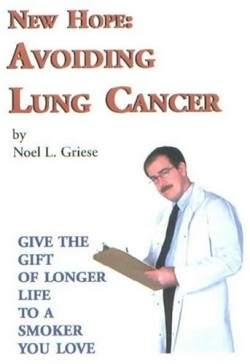
New Hope
How Even Smokers Can Avoid Lung Cancer
In the last century, a few years before cigarettes became widely popular, a professor of medicine visited a hospital ward in which he found a patient suffering from lung cancer. The professor immediately summoned one of his students, telling the young man that lung cancer was so rare that he might never see another case.
Alas, he was wrong. In subsequent years, largely as a result of cigarette smoking, the incidence of lung cancer increased exponentially, producing the current global epidemic in which 500 million people alive in the world today will eventually die prematurely. By the 2030s, says the author, who works with the Georgia Institute for Lung Cancer Research and edits the online newsletter Current CancerNews, the death rate of lung cancer victims around the world will reach ten million annually.
Griese is better known, perhaps, in the public relations world, both as a practitioner and author, and for his decades of service to the American Cancer Society and the American Lung Association. His health writing, however, is quite impressively informed and manifestly up-to-date.
Despite the dire predictions reported in the opening pages of New Hope, this book really is about hope, about the possibility of individuals choosing to remove themselves from the high-risk groups in which most lung-cancer deaths will occur. Lung cancer remains the biggest cancer killer, accounting for twenty-eight percent of all deaths-more than for breast, prostate, and colon cancer combined. The five-year survival rate is only fourteen percent, chiefly because of the difficulty of detecting lung cancer while it is still in its early, localized form.
New methods of earlier detection, however, using CT scans and PET scans instead of X-rays, are expected to make treatment vastly more successful, improving the survival rate to “upwards of seventy percent,” Griese says.
In the meantime, smokers must make up their minds to quit. The author explains recent lawsuits against tobacco companies, and lists and discusses the likely consequences of smoking. He also recommends changes in lifestyle that can reduce vulnerability to cancer and a number of other diseases as well. Further, as he says, as many as 12,000 cases of lung cancer each year result from exposure to radiation, asbestos, radon, and secondhand smoke in the workplace.
New Hope is a model of clarity and conciseness, its construction reflecting a fine sense of how much information to provide and how best to present it. Every page conveys the author’s deep sense of purpose and his commitment to the ongoing fight against this fearsome disease.
Reviewed by
Harold Cordry
Disclosure: This article is not an endorsement, but a review. The publisher of this book provided free copies of the book to have their book reviewed by a professional reviewer. No fee was paid by the publisher for this review. Foreword Reviews only recommends books that we love. Foreword Magazine, Inc. is disclosing this in accordance with the Federal Trade Commission’s 16 CFR, Part 255.
